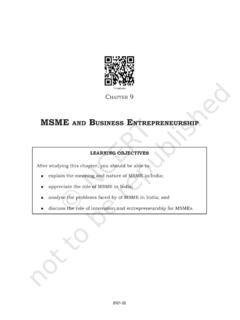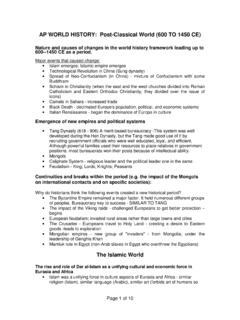Transcription of National Quali cations EXEMPLAR PAPER ONLY
1 H. EP14/H/11. National Quali cations EXEMPLAR PAPER ONLY. English Reading for Understanding, Analysis and Evaluation Text Date Not applicable Duration 1 hour 30 minutes Due to Copyright reasons, a full version of this question PAPER is available on SQA's secure site for centres to access and is strictly for classroom use only. Total marks 30. Read the passages carefully and then attempt ALL questions, which are printed on a separate sheet.. *EP14H11*. The following two passages focus on cities. Passage 1. In the first passage, the journalist Deyan Sudjic, writing in The Observer newspaper, considers the growth of cities in the modern world. The Future of the City . In a world changing faster now than ever before, the dispossessed and the ambitious are flooding into cities swollen out of all recognition. Poor cities are struggling to cope. Rich cities are reconfiguring themselves at breakneck speed. China has created an industrial powerhouse from what were fishing villages in the 1970s.
2 Lagos and Dhaka attract a thousand new arrivals every 5 day. In Britain, central London's population has started to grow again after 50 years of decline. We have more big cities now than at any time in our history. In 1900, only sixteen had a population of one million; now it's more than 400. Not only are there more of them, they are larger than ever. In 1851, London had two million people. It was the largest city in the world by a long way, twice the size of Paris, its nearest rival. That version of London would seem like a 10 village now. By the official definition, London has getting on for eight million people, but in practical terms, it's a city of 18 million, straggling most of the way from Ipswich to Bournemouth in an unforgiving rash of business parks and designer outlets, gated housing and logistics depots. Having invented the modern city, 19th century Britain promptly reeled back in horror at what it had done. To the Victorians exploring the cholera-ridden back alleys of London's East End, the 15 city was a hideous tumour sucking the life out of the countryside and creating in its place a vast polluted landscape of squalor, disease and crime.
3 In their eyes, the city was a place to be feared, controlled and, if possible, eliminated. Such attitudes continue to shape thinking about the city. Yet, like it or not, at some point in 2008, the city finally swallowed the world. The number of people living in cities overtook those 20 left behind in the fields. It's a statistic that seems to suggest some sort of fundamental species change, like the moment when mankind stopped being hunter gatherers and took up agriculture. The future of the city has suddenly become the only subject in town. It ranges from tough topics such as managing water resources, economic policy, transport planning, racial tolerance and law enforcement to what is usually presented as the fluffier end of the scale, such as 25 making public spaces people want to spend time in and deciding the colour of the buses. But it is this diversity which powerfully affirms the city as mankind's greatest single invention. For all their agonies, cities must be counted as a positive force .
4 They are an engine of growth, a machine for putting the rural poor onto the first rung of urban prosperity and freedom. Look at London, a city that existed for several centuries before anything approximating England had 30 been thought of. It has a far stronger sense of itself and its identity than Britain as a whole or England. It has grown, layer on layer, for 2000 years, sustaining generation after generation of newcomers. You see their traces in the Spitalfields district, where a French Huguenot chapel became, successively, a synagogue and a mosque, tracking the movement of waves of migrants from 35 poverty to suburban comfort. London's a place without an apparent structure that has proved extraordinarily successful at growing and changing. Its old residential core, sheltering in the approaches to its Tower of London fortress, has made the transition into the world's busiest banking centre. Its market halls and power stations have become art galleries and piazzas.
5 Its simple terraced streets, built for the clerks of the Great Western Railway in Southall, have 40 become home to the largest Sikh community outside India. Page two And all of these worlds overlap in space and time. London is different for all its people. They make the most of the elements in it that have meaning for them and ignore the rest. A city is an la carte menu. That is what makes it different from a village, which has little room for tolerance and difference. And a great city is one in which as many people as possible can make 45 the widest of choices from its menu. The cities that work best are those that keep their options open, that allow the possibility of change. The ones that are stuck, overwhelmed by rigid, state-owned social housing, or by economic systems that offer the poor no way out of the slums, are in trouble. A successful city is one that makes room for surprises. A city that has been trapped by too much gentrification or 50 too many shopping malls will have trouble generating the spark that is essential to making a city that works.
6 Successful cities are the ones that allow people to be what they want; unsuccessful ones try to force them to be what others want them to be. A city of freeways like Houston or Los Angeles forces people to be car drivers or else traps them in poverty. A successful city has a public 55 transport system that is easy to use; an unsuccessful city tries to ban cars. A successful city has room for more than the obvious ideas about city life, because, in the end, a city is about the unexpected, about a life shared with strangers and open to new ideas. An unsuccessful city has closed its mind to the future. Page three Passage 2. Permission has not yet been received from DEMOS to reproduce The Dreaming City, a report about Glasgow's future produced by a political think tank , in the Higher English EXEMPLAR Question PAPER on SQA's open access site. The passage is reproduced in the EXEMPLAR Question PAPER held on SQA's secure site which centres can access through their SQA co-ordinator, strictly for classroom use only.
7 The report is readily available in print and online to accompany the questions below. [END OF EXEMPLAR TEXT]. Page four H. EP14/H/21. National Quali cations EXEMPLAR PAPER ONLY. English Reading for Understanding, Analysis and Evaluation Questions Date Not applicable Duration 1 hour 30 minutes Total marks 30. Attempt ALL questions. Write your answers clearly in the answer booklet provided. In the answer booklet you must clearly identify the question number you are attempting. Use blue or black ink. Before leaving the examination room you must give your answer booklet to the Invigilator;. if you do not, you may lose all the marks for this PAPER .. *EP14H21*. MARKS. Passage 1 Questions 1. Re-read lines 1 12. (a) From the first paragraph, identify two types of people who are attracted to cities. Use your own words in your answer. 2. (b) By referring to at least two examples from lines 1 12, explain how the writer uses specific places to develop his argument about cities.
8 Use your own words as far as possible. 3. 2. Re-read lines 13 17. By referring to at least two language features, analyse how the writer conveys the Victorians' disgust at the city they created. 4. 3. Re-read lines 18 26. By referring to at least two language features, analyse how these lines convey the growing importance of cities. 4. 4. Re-read lines 27 45. (a) Explain the function of lines 27 28 ( For all their agonies..urban prosperity and freedom. ) in the development of the writer's argument. You should make close reference to the passage in your answer. 2. (b) Analyse how sentence structure and imagery are used in lines 27 45 to develop the idea of the city as a positive force '. 4. 5. Re-read lines 46 55. In your own words, summarise the differences between successful and unsuccessful cities. 4. 6. Re-read lines 56 58. Evaluate the effectiveness of the final paragraph as a conclusion to the passage as a whole. 2. Question on both passages 7. Both writers express their views about cities.
9 Identify key areas on which they agree. In your answer, you should refer in detail to both passages. 5. You may answer this question in continuous prose or in a series of developed bullet points. [END OF EXEMPLAR QUESTION PAPER ]. Page two Acknowledgement of Copyright Passage 1 Article is adapted from Cities on the Edge of Chaos by Deyan Sudjic, taken from The Observer, 9 March 2008. Guardian News and Media Ltd 2008. Page three H. EP14/H/21. National Quali cations EXEMPLAR PAPER ONLY. English Reading for Understanding, Analysis and Evaluation Marking Instructions These Marking Instructions have been provided to show how SQA would mark this EXEMPLAR Question PAPER . The information in this publication may be reproduced to support SQA qualifications only on a non-commercial basis. If it is to be used for any other purpose, written permission must be obtained from SQA's Marketing team on Where the publication includes materials from sources other than SQA (ie secondary copyright), this material should only be reproduced for the purposes of examination or assessment.
10 If it needs to be reproduced for any other purpose it is the user's responsibility to obtain the necessary copyright clearance.. H. EP14/H/21. National Quali cations EXEMPLAR PAPER ONLY. English Reading for Understanding, Analysis and Evaluation Marking Instructions These Marking Instructions have been provided to show how SQA would mark this EXEMPLAR Question PAPER . The information in this publication may be reproduced to support SQA qualifications only on a non-commercial basis. If it is to be used for any other purpose, written permission must be obtained from SQA's Marketing team on Where the publication includes materials from sources other than SQA (ie secondary copyright), this material should only be reproduced for the purposes of examination or assessment. If it needs to be reproduced for any other purpose it is the user's responsibility to obtain the necessary copyright clearance.. General marking principles for Higher English: Reading for Understanding, Analysis and Evaluation This information is provided to help you understand the general principles you must apply when marking candidate responses to questions in this PAPER .



